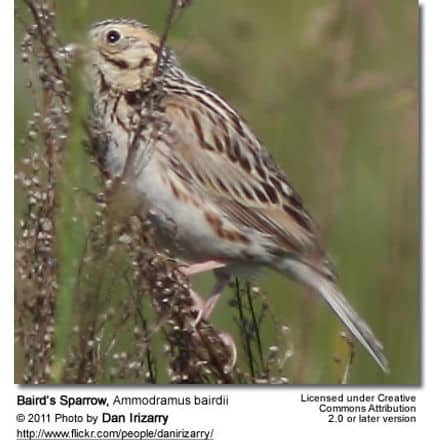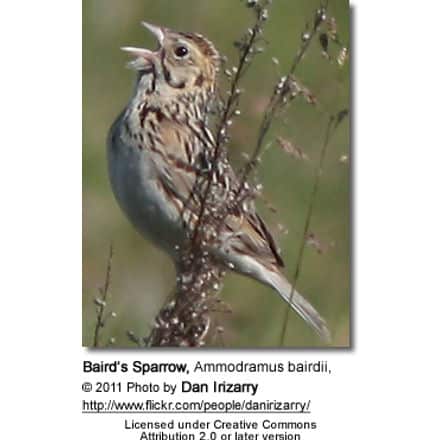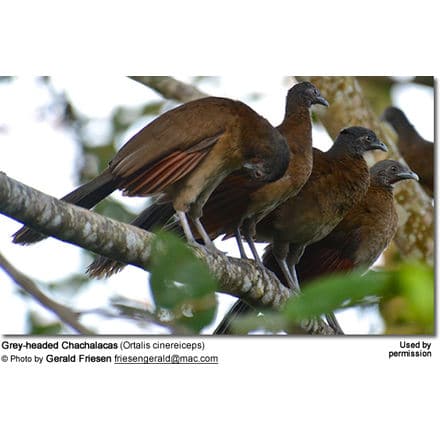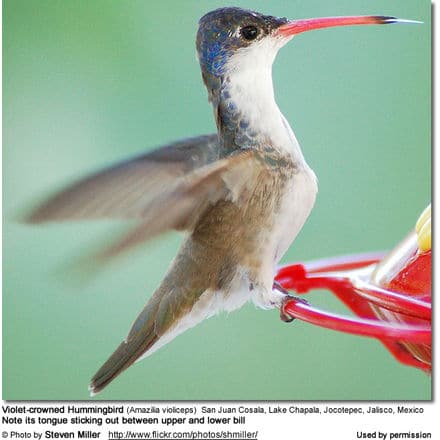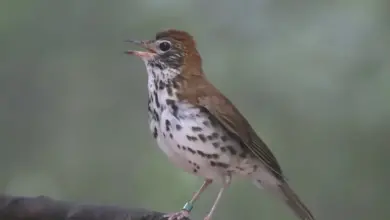Baird’s Sparrows
The Baird’s Sparrows, Ammodramus bairdii, is a small sparrow.
This bird was named after Spencer Fullerton Baird, an American naturalist.
Description:
These birds have a large bill, a large flat head, and a short forked tail. They have brown upperparts and white underparts, with streaking on the back, breast, and flanks. The face, nape (back of the neck) and crown stripe are yellowish.
Range / Distribution:
Their breeding habitat is tallgrass prairie regions in southern central Canada and the northern mid-western United States. The nest is an open cup in a well-hidden grassy location on the ground.
These birds migrate to the southwestern United States and northern Mexico.
These birds usually nest in small loose colonies. Males sing from perches within their nesting territory. The song consists of a short series of high notes followed by a trill. This bird is more often seen than heard.
This bird’s numbers have decreased with the loss of suitable habitat.
Diet / Feeding:
They forage on the ground, mainly eating insects in summer and seeds in winter.
References
- BirdLife International (2004). Ammodramus bairdii. 2006. IUCN Red List of Threatened Species. IUCN 2006. Retrieved on 5 May 2006. Database entry includes justification for why this species is of least concern
Book
- Green, M. T., P. E. Lowther, S. L. Jones, S. K. Davis, and B. C. Dale. 2002. Baird’s Sparrow (Ammodramus bairdii). In The Birds of North America, No. 638 (A. Poole and F. Gill, eds.). The Birds of North America, Inc., Philadelphia, PA.
Reports
- Anonymous (1993). Canadian Baird’s sparrow recovery plan. Ottawa: Recovery of Nationally Endangered Wildlife Committee, 1993. vii, 28 p. (36 pages)
- De Smet KD. (1991). Manitoba’s threatened and endangered grassland birds project: 1990 update. Winnipeg: Manitoba Natural Resources, Wildlife Branch, 1991. iv, 47 p. (53 pages).
- De Smet KD. (1992). Manitoba’s threatened and endangered grassland birds: 1991 update and five-year summary. Winnipeg: Manitoba Natural Resources, Wildlife Branch, 1992. vi, 77 p. (85 pages)
- De Smet KD and Miller WS. (1989). Status report on the Baird’s sparrow, Ammodramus bairdii, in Canada. Ottawa: Committee on the Status of Endangered Wildlife in Canada, 1989. ii, 28 p. (34 pages).
Thesis
- Ahlering MA. Ph.D. (2005). Settlement cues and resource use by Grasshopper Sparrows and Baird’s Sparrows in the Upper Great Plains. University of Missouri – Columbia, United States, Missouri.
- Davis SK. Ph.D. (2003). Habitat selection and demography of mixed-grass prairie songbirds in a fragmented landscape. The University of Regina (Canada), Canada.
- Gamble K. M.S. (2005). Habitat use in Baird’s and grasshopper sparrows. University of Missouri – Columbia, United States, Missouri.
- Green MT. Ph.D. (1992). Adaptations of Baird’s sparrows (Ammodramus bairdii) to grasslands: Acoustic communication and nomadism. The University of North Carolina at Chapel Hill, United States, North Carolina.
- Klippenstine DR. M.Sc. (2005). Can egg mimicry by Brown-headed Cowbirds explain the acceptance of brood parasitism by grassland passerines? University of Manitoba (Canada), Canada.
- Mahon CL. M.Sc. (1995). Habitat selection and detectability of Baird’s sparrows in southwestern Alberta. University of Alberta (Canada), Canada.
Articles
- Ahlering MA, Johnson DH and Faaborg J. (2006). Conspecific attraction in a grassland bird, the Baird’s Sparrow. Journal of Field Ornithology. vol 77, no 4. pp. 365–371.
- Bolduc D. (1969). Bairds Sparrow Occurrence Clay County Minnesota USA. Loon. vol 41, no 1.
- Dale BC, Martin PA, and Taylor PS. (1997). Effects of hay management on grassland songbirds in Saskatchewan. Wildlife Society Bulletin. vol 25, no 3. pp. 616–626.
- Davis SK. (2003). Nesting ecology of mixed-grass prairie songbirds in southern Saskatchewan. Wilson Bulletin. vol 115, no 2. pp. 119–130.
- Davis SK. (2004). Area sensitivity in grassland passerines: Effects of patch size, patch shape, and vegetation structure on bird abundance and occurrence in southern Saskatchewan. Auk. vol 121, no 4. pp. 1130–1145.
- Davis SK. (2005). Nest-site selection patterns and the influence of vegetation on nest survival of mixed-grass prairie passerines. Condor. vol 107, no 3. pp. 605–616.
- Davis SK, Brigham RM, Shaffer TL and James PC. (2006). Mixed-grass prairie passerines exhibit weak and variable responses to patch size. Auk. vol 123, no 3. pp. 807–821.
- Davis SK, Duncan DC and Skeel M. (1999). Distribution and habitat associations of three endemic grassland songbirds in southern Saskatchewan. Wilson Bulletin. vol 111, no 3. pp. 389–396.
- Davis SK, Duncan DC, and Skeel MA. (1996). The Baird’s Sparrow: Status resolved. Blue Jay. vol 54, no 4. pp. 185–191.
- Davis SK and Sealy SG. (1998). Nesting biology of the Baird’s sparrow in southwestern Manitoba. Wilson Bulletin. vol 110, no 2. pp. 262–270.
- Dieni JS and Jones SL. (2003). Grassland songbird nest site selection patterns in northcentral Montana. Wilson Bulletin. vol 115, no 4. pp. 388–396.
- Gordon CE. (2000). Movement patterns of wintering grassland sparrows in Arizona. Auk. vol 117, no 3. pp. 748–759.
- Johnson DH and Igl LD. (2001). Area requirements of grassland birds: A regional perspective. Auk. vol 118, no 1. pp. 24–34.
- Kyllingstad H. (1977). Bairds Sparrow Singing at Rothsay. Loon. vol 49, no 2.
- Madden EM, Hansen AJ, and Murphy RK. (1999). Influence of prescribed fire history on habitat and abundance of passerine birds in northern mixed-grass prairie. Canadian Field Naturalist. vol 113, no 4. pp. 627–640.
- Madden EM, Murphy RK, Hansen AJ and Murray L. (2000). Models for guiding management of prairie bird habitat in northwestern North Dakota. American Midland Naturalist. vol 144, no 2. pp. 377–392.
- Maher WJ. (1979). Nestling Diets of Prairie Passerine Birds at Matador Saskatchewan Canada. Ibis. vol 121, no 4. pp. 437–452.
- Marks JS and Nordhagen T. (2005). Type locality of Ammodramus bairdii (Audubon). Auk. vol 122, no 1. pp. 349–350.
- Martin PA and Forsyth DJ. (2003). Occurrence and productivity of songbirds in prairie farmland under conventional versus minimum tillage regimes. Agriculture Ecosystems and Environment. vol 96, no 1-3. pp. 107–117.
- Martin PA, Johnson DL, Forsyth DJ, and Hill BD. (2000). Effects of two grasshopper control insecticides on food resources and reproductive success of two species of grassland songbirds. Environmental Toxicology and Chemistry. vol 19, no 12. pp. 2987–2996.
- Pylypec B. (1991). Impacts of Fire on Bird Populations in a Fescue Prairie. Canadian Field Naturalist. vol 105, no 3. pp. 346–349.
- Sutter GC and Brigham RM. (1998). Avifaunal and habitat changes resulting from the conversion of native prairie to crested wheatgrass: Patterns at songbird community and species levels. Canadian Journal of Zoology. vol 76, no 5. pp. 869–875.
- Sutter GC, Troupe T and Forbes M. (1995). The abundance of Baird’s sparrows, Ammodramus bairdii, in native prairie and introduced vegetation. Ecoscience. vol 2, no 4. pp. 344–348.
- Voelker G. (2004). Can migrants do it faster? Accelerated molt of Baird’s Sparrows and further insights into southwestern molting grounds. Condor. vol 106, no 4. pp. 910–914.
- Wilson SD and Belcher JW. (1989). Plant and Bird Communities of Native Prairie and Introduced Eurasian Vegetation in Manitoba Canada. Conservation Biology. vol 3, no 1. pp. 39–44.
Copyright: Wikipedia. This article is licensed under the GNU Free Documentation License. It uses material from Wikipedia.org
Please Note: The articles or images on this page are the sole property of the authors or photographers. Please contact them directly with respect to any copyright or licensing questions. Thank you.

